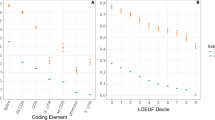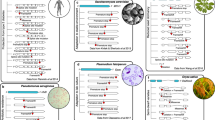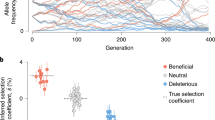Abstract
Genomic data encode past evolutionary events and have the potential to reveal the strength, rate and biological drivers of adaptation. However, joint estimation of adaptation rate (α) and adaptation strength remains challenging because evolutionary processes such as demography, linkage and non-neutral polymorphism can confound inference. Here, we exploit the influence of background selection to reduce the fixation rate of weakly beneficial alleles to jointly infer the strength and rate of adaptation. We develop a McDonald–Kreitman-based method to infer adaptation rate and strength, and estimate α = 0.135 in human protein-coding sequences, 72% of which is contributed by weakly adaptive variants. We show that, in this adaptation regime, α is reduced ~25% by linkage genome-wide. Moreover, we show that virus-interacting proteins undergo adaptation that is both stronger and nearly twice as frequent as the genome average (α = 0.224, 56% due to strongly beneficial alleles). Our results suggest that, while most adaptation in human proteins is weakly beneficial, adaptation to viruses is often strongly beneficial. Our method provides a robust framework for estimation of adaptation rate and strength across species.
This is a preview of subscription content, access via your institution
Access options
Access Nature and 54 other Nature Portfolio journals
Get Nature+, our best-value online-access subscription
$29.99 / 30 days
cancel any time
Subscribe to this journal
Receive 12 digital issues and online access to articles
$119.00 per year
only $9.92 per issue
Buy this article
- Purchase on Springer Link
- Instant access to full article PDF
Prices may be subject to local taxes which are calculated during checkout




Similar content being viewed by others
Data availability
Supplemental Data Table 1 is provided on the publisher’s website. The data that we used to parameterize our model are also available online at https://github.com/uricchio/mktest. Columns in Supplementary Data Table 1 are as follows: 1, Ensembl coding gene identification; 2, number of non-synonymous polymorphic sites; 3, respective derived allele frequencies of these sites separated by commas; 4, number of synonymous polymorphic sites; 5, respective frequency-derived allele frequencies of these sites; 6, number of fixed non-synonymous substitutions on the human branch; and 7, number of fixed synonymous substitutions on the human branch.
Code availability
The code that we used to parameterize our model is freely available online at https://github.com/uricchio/mktest.
References
Darwin, C. On the Origin of Species (Murray, 1859).
Wallace, A. R. Darwinism: an exposition of the theory of natural selection with some of its applications (MacMillan & Co., 1889).
Wright, S. On the roles of directed and random changes in gene frequency in the genetics of populations. Evolution 2, 279–294 (1948).
Kimura, M. et al. Evolutionary rate at the molecular level. Nature 217, 624–626 (1968).
Ohta, T. Slightly deleterious mutant substitutions in evolution. Nature 246, 96 (1973).
Kimura, M. Preponderance of synonymous changes as evidence for the neutral theory of molecular evolution. Nature 267, 275 (1977).
McDonald, J. H. & Kreitman, M. Adaptive protein evolution at the ADH locus in Drosophila. Nature 351, 652 (1991).
Fay, J. C., Wyckoff, G. J. & Wu, C.-I. Testing the neutral theory of molecular evolution with genomic data from Drosophila. Nature 415, 1024 (2002).
Pollard, K. S., Hubisz, M. J., Rosenbloom, K. R. & Siepel, A. Detection of nonneutral substitution rates on mammalian phylogenies. Genome Res. 20, 110–121 (2010).
Charlesworth, B. & Charlesworth, D. Neutral variation in the context of selection. Mol. Biol. Evol. 35, 1359–1361 (2018).
Corbett-Detig, R. B., Hartl, D. L. & Sackton, T. B. Natural selection constrains neutral diversity across a wide range of species. PLoS Biol. 13, e1002112 (2015).
Coop, G. Does linked selection explain the narrow range of genetic diversity across species? Preprint at bioRxiv https://doi.org/10.1101/042598 (2016).
Kern, A. D. & Hahn, M. W. The neutral theory in light of natural selection. Mol. Biol. Evol. 35, 1366–1371 (2018).
Jensen, J. D. et al. The importance of the neutral theory in 1968 and 50 years on: a response to Kern and Hahn 2018. Evolution 73, 111–114 (2018).
Leffler, E. M. et al. Revisiting an old riddle: what determines genetic diversity levels within species? PLoS Biol. 10, e1001388 (2012).
Galtier, N. Adaptive protein evolution in animals and the effective population size hypothesis. PLoS Genet. 12, e1005774 (2016).
Smith, N. G. C. & Eyre-Walker, A. Adaptive protein evolution in Drosophila. Nature 415, 1022 (2002).
Sawyer, S. A. & Hartl, D. L. Population genetics of polymorphism and divergence. Genetics 132, 1161–1176 (1992).
Tataru, P., Mollion, M., Glémin, S. & Bataillon, T. Inference of distribution of fitness effects and proportion of adaptive substitutions from polymorphism data. Genetics 207, 1103–1119 (2017).
Ratnakumar, A. et al. Detecting positive selection within genomes: the problem of biased gene conversion. Philos. Trans. R. Soc. London B 365, 2571–2580 (2010).
Fay, J. C., Wyckoff, G. J. & Wu, C.-I. Positive and negative selection on the human genome. Genetics 158, 1227–1234 (2001).
Eyre-Walker, A. & Keightley, P. D. Estimating the rate of adaptive molecular evolution in the presence of slightly deleterious mutations and population size change. Mol. Biol. Evol. 26, 2097–2108 (2009).
Messer, P. W. & Petrov, D. A. Frequent adaptation and the McDonald–Kreitman test. Proc. Natl Acad. Sci. USA 110, 8615–8620 (2013).
James, J. E., Piganeau, G. & Eyre-Walker, A. The rate of adaptive evolution in animal mitochondria. Mol. Ecol. 25, 67–78 (2016).
Enard, D., Cai, L., Gwennap, C. & Petrov, D. A. Viruses are a dominant driver of protein adaptation in mammals. eLife 5, e12469 (2016).
Pritchard, J. K., Pickrell, J. K. & Coop, G. The genetics of human adaptation: hard sweeps, soft sweeps, and polygenic adaptation. Curr. Biol. 20, R208–R215 (2010).
Messer, P. W. & Petrov, D. A. Population genomics of rapid adaptation by soft selective sweeps. Trends Ecol. Evol. 28, 659–669 (2013).
Berg, J. J. & Coop, G. A population genetic signal of polygenic adaptation. PLoS Genet. 10, e1004412 (2014).
Schrider, D. R. & Kern, A. D. Soft sweeps are the dominant mode of adaptation in the human genome. Mol. Biol. Evol. 34, 1863–1877 (2017).
Uricchio, L. H., Kitano, H. C., Gusev, A. & Zaitlen, N. A. An evolutionary compass for detecting signals of polygenic selection and mutational bias. Evol. Lett. 3, 69–79 (2019).
Elyashiv, E. et al. A genomic map of the effects of linked selection in Drosophila. PLoS Genet. 12, e1006130 (2016).
Charlesworth, B., Morgan, M. T. & Charlesworth, D. The effect of deleterious mutations on neutral molecular variation. Genetics 134, 1289–1303 (1993).
Barton, N. H. Linkage and the limits to natural selection. Genetics 140, 821–841 (1995).
McVicker, G., Gordon, D., Davis, C. & Green, P. Widespread genomic signatures of natural selection in hominid evolution. PLoS Genet. 5, e1000471 (2009).
Haller, B. C. & Messer, P. W. asymptoticMK: a web-based tool for the asymptotic McDonald–Kreitman test. G3 (Bethesda) 7, 1569–1575 (2017).
Evans, S. N., Shvets, Y. & Slatkin, M. Non-equilibrium theory of the allele frequency spectrum. Theor. Popul. Biol. 71, 109–119 (2007).
Kimura, M. Diffusion models in population genetics. J. Appl. Probab. 1, 177–232 (1964).
Phung, T. N., Huber, C. D. & Lohmueller, K. E. Determining the effect of natural selection on linked neutral divergence across species. PLoS Genet. 12, e1006199 (2016).
Consortium TGP et al. A global reference for human genetic variation. Nature 526, 68 (2015).
Boyko, A. R. et al. Assessing the evolutionary impact of amino acid mutations in the human genome. PLoS Genet. 4, e1000083 (2008).
Kim, B. Y., Huber, C. D. & Lohmueller, K. E. Inference of the distribution of selection coefficients for new nonsynonymous mutations using large samples. Genetics 206, 345–361 (2017).
Eyre-Walker, A., Woolfit, M. & Phelps, T. The distribution of fitness effects of new deleterious amino acid mutations in humans. Genetics 173, 891–900 (2006).
Hill, W. G. & Robertson, A. The effect of linkage on limits to artificial selection. Genet. Res. 8, 269–294 (1966).
Smith, J. M. & Haigh, J. The hitch-hiking effect of a favourable gene. Genet. Res. 23, 23–35 (1974).
Macpherson, J. M., Sella, G., Davis, J. C. & Petrov, D. A. Genomewide spatial correspondence between nonsynonymous divergence and neutral polymorphism reveals extensive adaptation in Drosophila. Genetics 177, 2083–2099 (2007).
Castellano, D., Coronado-Zamora, M., Campos, J. L., Barbadilla, A. & Eyre-Walker, A. Adaptive evolution is substantially impeded by Hill–Robertson interference in Drosophila. Mol. Biol. Evol. 33, 442–455 (2015).
Marsden, C. D. et al. Bottlenecks and selective sweeps during domestication have increased deleterious genetic variation in dogs. Proc. Natl Acad. Sci. USA 113, 152–157 (2016).
Bullaughey, K. L., Przeworski, M. & Coop, G. No effect of recombination on the efficacy of natural selection in primates. Genome Res. 18, 544–554 (2008).
Hussin, J. G. et al. Recombination affects accumulation of damaging and disease-associated mutations in human populations. Nature Genet. 47, 400 (2015).
Jensen, J. D., Thornton, K. R. & Andolfatto, P. An approximate Bayesian estimator suggests strong, recurrent selective sweeps in Drosophila. PLoS Genet. 4, e1000198 (2008).
Hernandez, R. D. et al. Classic selective sweeps were rare in recent human evolution. Science 331, 920–924 (2011).
Enard, D., Messer, P. W. & Petrov, D. A. Genome-wide signals of positive selection in human evolution. Genome Res. 24, 885–895 (2014).
Comeron, J. M. & Kreitman, M. Population, evolutionary and genomic consequences of interference selection. Genetics 161, 389–410 (2002).
Uricchio, L. H. & Hernandez, R. D. Robust forward simulations of recurrent hitchhiking. Genetics 197, 221–236 (2014).
Hernandez, R. D., Williamson, S. H. & Bustamante, C. D. Context dependence, ancestral misidentification, and spurious signatures of natural selection. Mol. Biol. Evol. 24, 1792–1800 (2007).
Ewing, G. B. & Jensen, J. D. The consequences of not accounting for background selection in demographic inference. Mol. Ecol. 25, 135–141 (2016).
Torres, R., Szpiech, Z. A. & Hernandez, R. D. Human demographic history has amplified the effects of background selection across the genome. PLoS Genet. 14, e1007387 (2018).
Huang, Y.-F. & Siepel, A. Estimation of allele-specific fitness effects across human protein-coding sequences and implications for disease. Preprint at bioRxiv https://doi.org/10.1101/441337 (2018).
Huber, C. D., Kim, B. Y., Marsden, C. D. & Lohmueller, K. E. Determining the factors driving selective effects of new nonsynonymous mutations. Proc. Natl Acad. Sci. USA 114, 4465–4470 (2017).
Yates, A. et al. Ensembl 2016. Nucleic Acids Res. 44, D710–D716 (2015).
Kent, W. J. BLAT—the BLAST-like alignment tool. Genome Res. 12, 656–664 (2002).
Löytynoja, A. & Goldman, N. webPRANK: a phylogeny-aware multiple sequence aligner with interactive alignment browser. BMC Bioinformatics 11, 579 (2010).
Hernandez, R. D. & Uricchio, L. H. SFS_CODE: more efficient and flexible forward simulations. Preprint at bioRxiv https://doi.org/10.1101/025064 (2015).
Uricchio, L. H., Torres, R., Witte, J. S. & Hernandez, R. D. Population genetic simulations of complex phenotypes with implications for rare variant association tests. Genet. Epidemiol. 39, 35–44 (2015).
Beaumont, M. A., Zhang, W. & Balding, D. J. Approximate Bayesian computation in population genetics. Genetics 162, 2025–2035 (2002).
Tennessen, J. A. et al. Evolution and functional impact of rare coding variation from deep sequencing of human exomes. Science 337, 64–69 (2012).
Acknowledgements
We thank A. Aw, N. Rosenberg and members of the Rosenberg and Petrov laboratories for helpful discussions. L.H.U. was partially supported by an IRACDA fellowship through NIGMS grant No. K12GM088033. L.H.U was supported by National Institutes of Health grant R01 HG005855 and National Science Foundation grant DBI-1458059 (to N. Rosenberg). We also thank the Stanford/SJSU IRACDA Program for support.
Author information
Authors and Affiliations
Contributions
Designed the research: L.H.U., D.A.P., D.E. Performed the modeling and simulations: L.H.U. Analyzed the data: L.H.U., D.A.P.. Designed inference procedure: L.H.U. Wrote the paper: L.H.U. Edited and approved paper: L.H.U., D.A.P., D.E.
Corresponding authors
Ethics declarations
Competing interests
The authors declare no competing interests.
Additional information
Publisher’s note: Springer Nature remains neutral with regard to jurisdictional claims in published maps and institutional affiliations.
Supplementary information
Supplementary Information
Supplementary Methods, Supplementary Figs. 1–20
Supplementary Data 1
Data we used to parameterize the model.
Rights and permissions
About this article
Cite this article
Uricchio, L.H., Petrov, D.A. & Enard, D. Exploiting selection at linked sites to infer the rate and strength of adaptation. Nat Ecol Evol 3, 977–984 (2019). https://doi.org/10.1038/s41559-019-0890-6
Received:
Accepted:
Published:
Issue Date:
DOI: https://doi.org/10.1038/s41559-019-0890-6
This article is cited by
-
CEGA: a method for inferring natural selection by comparative population genomic analysis across species
Genome Biology (2023)
-
The relative fitness of the de novo variants in general Lithuanian population vs. in individuals with intellectual disability
European Journal of Human Genetics (2022)
-
Variation of the adaptive substitution rate between species and within genomes
Evolutionary Ecology (2020)



